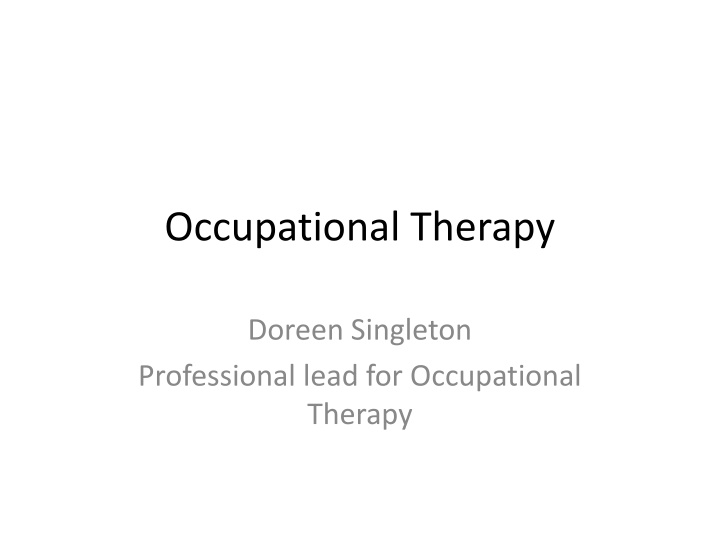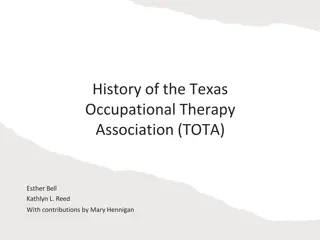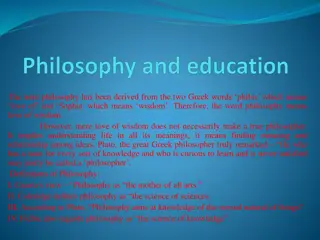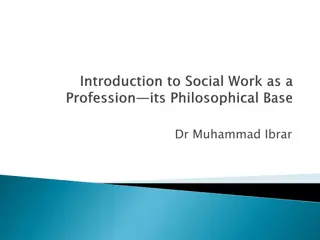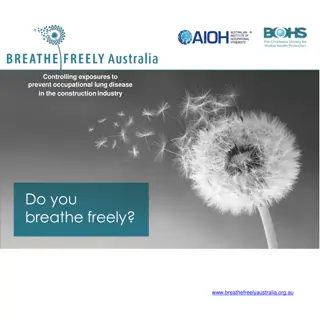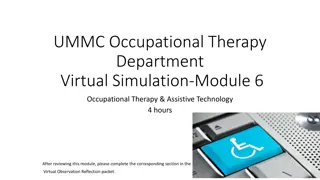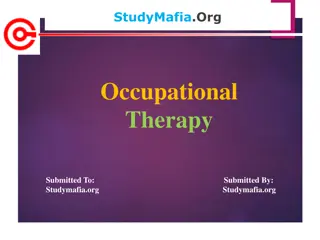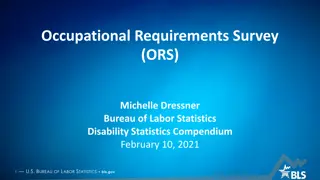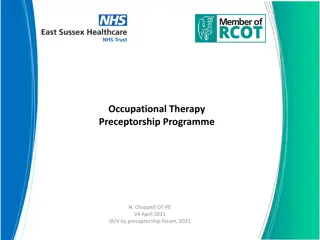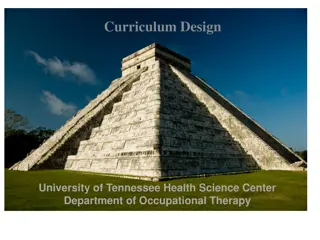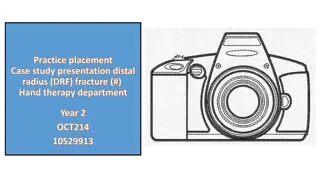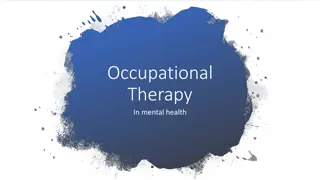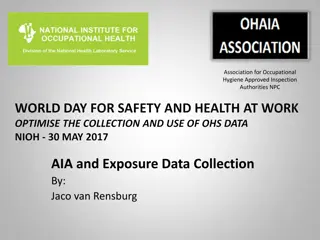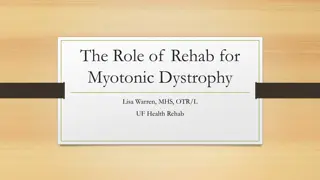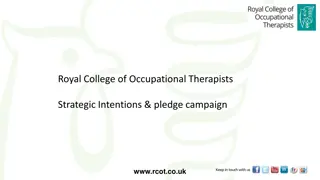Occupational Therapy: Philosophy, Models, and Practice
Occupational therapy explores the intrinsic activity and creativity in individuals, promoting health and well-being through balanced activities. Occupations shape our identity and roles in life, facilitating adaptation and creating meaning. Various models and frameworks guide OT practice, emphasizing the therapeutic nature of human occupation.
Download Presentation

Please find below an Image/Link to download the presentation.
The content on the website is provided AS IS for your information and personal use only. It may not be sold, licensed, or shared on other websites without obtaining consent from the author.If you encounter any issues during the download, it is possible that the publisher has removed the file from their server.
You are allowed to download the files provided on this website for personal or commercial use, subject to the condition that they are used lawfully. All files are the property of their respective owners.
The content on the website is provided AS IS for your information and personal use only. It may not be sold, licensed, or shared on other websites without obtaining consent from the author.
E N D
Presentation Transcript
Occupational Therapy Doreen Singleton Professional lead for Occupational Therapy
Occupational therapy What experience do you have of It ? And what does it mean to you ? One thing that you want to learn from this session?
We are all Occupational Beings Intrinsically active and creative Balanced activities Health and wellbeing Capacity to transform premeditated and autonomous action Shaping and being shaped interactions and environment Creating identity and meaning through doing
Occupational Therapy Facilitates Adaptation Occupations are key to people s health and wellbeing, because they make us who we are and shape our roles and responsibilities in life ` Cot careers handbook 2015 -2016 accessed 21.6.16 Occupations are everything we must do ,need to do, want to do Well being is about occupational balance Activity can be an effective medium for remediating dysfunction, facilitating adaption and creating identity COT 2009
Occupational Therapy Paradigm Philosophy, values and Ethics , knowledge OT practice framework Occupation based models Overarching theories Frames of reference practice guidelines in specific domains ( M Cole and R Tufano 2007)
Model of human Occupation-MOHO Kielhofner adapted used in many services uses own language used in CPFT for efficacy of the service and improved service outcomes across the services
Kielhofner (2002 p169 or 2008 p148) 7 general questions generated from the theory
The Canadian Model of Performance and Engagement environment person occupation O T D o m a i n
Why do we use theory and models Humans are occupational Occupation is therapeutic Occupation affects health and well-being Occupation gives structure to time and life Occupation defines cultures and individuals within those cultures Each person s occupation is unique. Therefore if we use occupation as a bridge between self and environment individuals can achieve engagement.
Occupational therapy Is holistic -Looks at all aspects of the person life physical , psychological and social, includes spiritual and emotional Is person centred Aims to improve occupational : engagement and performance Promoting independence and choice and control
Occupational Therapy in NHS Moved into more specialist areas in health . Find in approximately 50+ of the services in CPFT , mental health, physical health , childrens and young people services Work in acute sectors and specific health streams safe discharge facilitation, promoting occupational function Cumbria includes MBUH and NCUH , Westmorland general CIC and the West Cumberland hospital. Interface with hospitals further afield with elective surgery and specialist unit Predominantly time limited service and focussed on outcomes and efficacy Approx 250 staff not FTE
Occupational therapy role in adult social care Previously in the work force for two specific reasons Chronically Sick and Disabled Persons Act 1970- section 2 Housing Grants Construction and Regeneration Act 1996 as amended Mainly concerned with services provision for disabled people including functional assessments and equipment and adaptations provision Mainly dealing with long term issue 39 staff not FTE
current legislation The Care Act 2014 1. prevention secondary and tertiary Safety and independence Minimising the effects of disability usually involves skills relating to moving and handling postural management 2. Minor adaptations and equipment 3. Reablement. Housing construction and regeneration Act 1990- funding now under the better care fund not directly to district councils/ Housing Authority 1 Disabled Facilities Grant are evolving 2. Rehousing
The change in legislation has changed practice CS and DP Act 1970 Targeted approach to assessment Assessments Deficit based Targeted approach to deficits in support plan Contingencies gradually introduced as good practice Little effective prevention across the system Positive risk taking approach The Care Act Holistic approach to assessment Assessment strength based Support plan strength based and holistic Contingencies essential part Duty for prevention at every stage Prevention services developing positive risk taking approach is essential Opportunities and threats No more capacity Need to work smarter
Adults social care Seen as a prevention service :secondary , tertiary Skill base is, enabling , facilitating occupational engagement Assessment includes functional assessment as well as assessment interview to inform re the psychological and social aspects. Considers informal carer as joint or as self Solution is occupational adaptation focus for the individual practical solutions may be : advice information and alternative techniques ,use of community assets equipment hoisting , postural seating adaptation- of the physical environment In social care we don t treat people , we enable reablement
Factors considered when arriving at decisions Desired outcomes Assessment physical, procedural, care plans and actions of others Risk balance quality outcomes Risk, risk management, risk, removal or reduction and review and monitor The law, case law precedent The standards Regulatory body HCPC section 6 standards Positive risk guidance The person mental capacity (MCA 2005) Collaboration, MDT approach The organisational strategy The individual practitioner -experience
Solutions must be substantiated By defensible decisions just like social workers ! A defensible decision has been defined as one that will withstand hindsight scrutiny should the case go wrong I and negative outcomes have occurred . (Carson , 1996:kemshall ,1998) a decision is defensible if, in spite of a negative outcome, it can be demonstrated that all reasonable steps had been taken in its assessment and management. (Kemshall 2011)
Risk taking for positive outcomes the person is capacitated in the area of interest. For those people that choose to make decisions against best advice it is safer than the alternative safer than doing nothing
Positive Risk Taking 88 years young Capacitated Independent spirit Feisty
Current DFG grant can be used for adaptations to give better freedom of movement into and around the home and/or to provide essential facilities within it. Examples of the work which may be covered by this assistance are: widening doors and installing ramps providing or improving access to rooms and facilities - for example, by installing a stair lift or providing a downstairs bathroom bathroom conversion e.g. providing level access shower, accessible WC and wash hand basin improving or providing a heating system which is suitable for the disabled person's needs improving access to and movement around the home to enable you to care for another person who lives in the property, such as a child alterations to door widths and ramps specialist equipment i.e. baths/ kitchens The maximum mandatory values of works is 30,000 in England; however the local authority can use discretionary powers released through a later RRO to increase the value of works.
Procedures If you learn one thing from today it is to work in partnership If there is equipment in place someone has very probably supplied or advised about it is it meeting their needs? who supplied it ? often for carers benefit as well as that of the person P19-Support and Care at Home Moving and Handling (Incorporating Formal and Informal Carers in Moving and Handling Tasks, and Requirements for Two Carers) P33- INSPECTION OF COMMUNITY EQUIPMENT P39 PROCEDURE- Community Equipment Transition- include Occupational therapy involvement
Whats Occupational Therapy got to do with you Should be a whole systems approach across organisations should be holistic assessment of person ( carer)and review Need to involve other members of the multi- disciplinary team Need to ensure that outcomes achieved
Review When reviewing please ensure that you take a holistic approach if people have equipment check where it originated from and if it is still meeting needs . We have a equipment procedure Inspection of community equipment procedure moving and handling procedure community equipment procedure
minor adaptations equipment and eligibility Adaptations under 1k Process in house criteria and cost equipment free - Improving prevention streams to self serve other than bringing everyone into the statutory service
Moving and handling independence informal /formal carer Rules and regulations LOLER 1998 PUWER 1998 , MHOR 1992 (as amended 2002), HSAW ACT 1974 management of health and safety at work regs 1999. Transfer between agencies ONGOING REVIEWS legal mandate
Wellbeing principle Participation Dignity Domestic, Family and Personal Protection Control Suitable Accommodation Contribution For our service users the well being principle only works, if we work together A holistic approach
Was the area you wanted to know about addressed? 1 thing you have learnt 1 thing you will apply
References Christianson, C. Baum, C. Person environment occupational performance: a conceptual model of practice. Cramm, H. (2003) The person environment occupation circle tool: a simple way to bridge theory into practice. Available at: http://www.caot.ca/otnow/may09/peo.pdf Strong, S. Rigby, P. Stewart, D.Law, M. Letts, L. Cooper, B. (1999) Application of the person environment occupation model: A practical tool. Available at: http://cjo.sagepub.com/content/66/3/122.short?rss=1&ssource=mfr Polatajko, H.J., Townsend, E.A. & Craik, J. 2007. Canadian Model of Occupational Performance and Engagement (CMOP-E). In Enabling Occupation II: Advancing an Occupational Therapy Vision of Health, Well- being, & Justice through Occupation. E.A. Townsend & H.J. Polatajko, Eds. Ottawa, ON: CAOT Publications ACE. 22-36. Kielhofner, G. (2008) Model of Human Occupation: Theory and Application (Model of Human Occupation: Theory & Application) 4th Edition, Wolters Klvwer, USA
